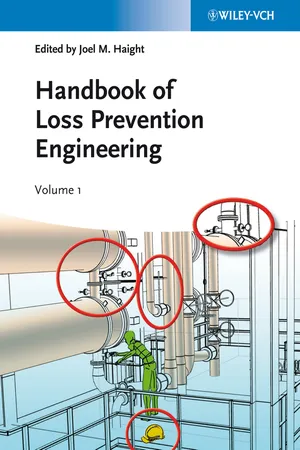![]() Contents to Volume 1
Contents to Volume 1![]()
Preface
Loss Prevention Engineering involves the engineering required to help us prevent accidental, undesired loss-producing incidents. It is a diverse application of engineering that can call upon every engineering discipline and many other scientific and social science disciplines as well as just about every aspect of industrial life. It is generally assumed that, by definition, we do not want to experience this type of loss. In response to that, the authors of this book seek to inform the engineering community about what must be considered when designing, operating and maintaining systems and processes so that accidental and undesired failures or loss-producing incidents (including human injury) are less likely to occur or, if they do, that they result in lesser consequences.
However, because loss prevention engineering is such a diverse and broadly demanding application of engineering and scientific principles and even if we limit the subject to preventing accidental loss incidents (such as automobile crashes, sporting accidents, etc.), we would still never be able to cover all the relevant and important topics that would be needed in just one book. So, we have chosen to cover the topics relating to engineering industrial processes to prevent or reduce loss from accidental and undesired incidents. It is the expectation of our authors to present to you, our readers, a thorough collection and summary of what is known in industry about preventing work related injuries and other undesired, accidental loss incidents. Some of our readers will already be well-versed in such fields as safety engineering, process safety management, fire protection engineering, industrial hygiene, or environmental engineering, but it is expected that not many engineers are well-versed in all of these fields. Therefore, with the input of nearly 40 authors, and since many find themselves to be in need of information on any and all of these topic areas, the book encompasses parts of all of them. The book is grouped into major topic areas of similar subject matter to lend cohesiveness to the information. Our authors present a number of case studies and exercises that will help our readers to put the principles and theories of loss prevention engineering into proper day-to-day perspective. It is also the expectation of the authors that our readers will find this book to be a necessity any time each of you are tasked with solving an engineering problem that could lead to a loss-producing incident, any time you find yourself assigned to a job in which loss prevention engineering is part of the defined responsibilities or any time you want to learn about loss prevention engineering as an occupation or field of study. This book provides you the information you will need in any or all of these cases. It is an excellent and thorough reference handbook that we hope you find useful in the everyday dispatch of your industrial duties.
A diverse and detailed publication like this would not be possible without the input of many people of a multitude of experiences, languages, countries of origin, and industrial backgrounds. Our authors hail from nine different countries, represent nearly 20 different industry categories, and have an average of about 20 years of experience in their fields. This book would not have been possible without them and I thank all of them for their significant and valuable contributions. I would also like to thank the reviewers of our chapters as it is an important aspect of this book to ensure that you, our readers, get more than just the opinions of one author. You will find that the material is widely accepted and is not just a “here's how we do things at our plant”-type book. All engineers are charged with a responsibility to protect people, equipment, facilities and operations and therefore, it is our hope that in reading this book you will learn something new and that you will enhance your organization's efforts to protect their operations and their people from injuries and other loss-producing incidents.
Pittsburgh
Joel M. Haight
January 2013
![]()
List of Contributors
Remigio Agraz-Boeneker
Primatech Inc.
50 Northwoods Boulevard
Columbus, OH 43235
USA
Tareq Ahram
University of Central Florida
Institute for Advanced Systems Engineering
Department of Industrial Engineering and Management Systems
4000 Central Florida Boulevard
Orlando, FL 32816
USA
Marjory E. Anderson
Architect of the Capitol
Ford House Office Building
Washington, DC 20515
USA
Craig Arthur Brown
6500 W 96th Drive
Westminster, CO 80021
USA
Geoffrey S. Barnard
Praxair Inc.
39 Old Ridgebury Road
Danbury, CT 06810
USA
Paul Baybutt
Primatech Inc.
50 Northwoods Boulevard
Columbus, OH 43235
USA
Warren K. Brown
1855 Campus Drive
Fairborn, OH 45324
USA
Leo J. DeBobes
Stony Brook University
School of Health Technology & Management
Health Sciences Level 1
Room 143
Stony Brook, NY 11794-8019
USA
Marek Dudek
Institute of Mining Technology KOMAG
ul. Pszczynska 37
Gliwice 44-101
Poland
Michael Farris
Anadarko Petroleum Corporation
1201 Lake Robbins Drive
The Woodlands, TX 77380
USA
Patrick Fortune
Suncor Energy
Alberta Boiler Safety Association
Board of Canadian Registered Safety Professionals
(Canadian Registered Safety Professional (CRSP))
...
